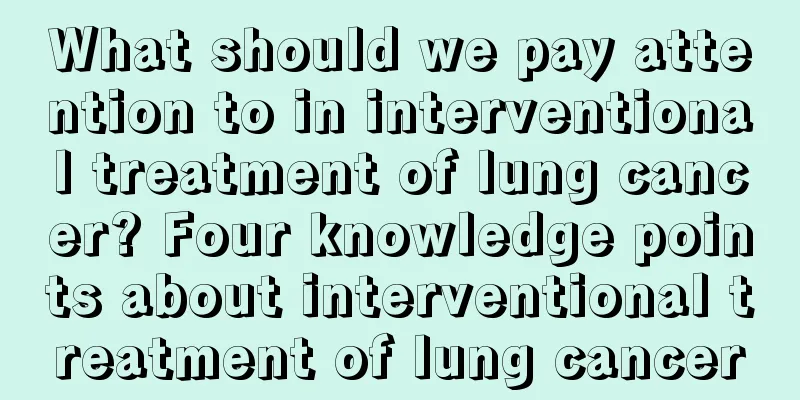What should we pay attention to in interventional treatment of lung cancer? Four knowledge points about interventional treatment of lung cancer

|
Interventional treatment of lung cancer is a palliative treatment. Its advantages are that it can relieve clinical symptoms, reduce patient pain, and prolong life. It is also simple to operate, less invasive, and highly repeatable. From the earliest and classic bronchial artery embolization and perfusion, to the later transpulmonary artery perfusion, tracheobronchial, cryotherapy such as hydrogen-nitrogen knife, and local treatment via fiberbronchoscope, or image-guided radiofrequency or energy-focusing knife treatment, stent treatment for superior vena cava obstruction, and percutaneous puncture of intratumoral drug injection, interventional treatment of lung cancer is gradually becoming a comprehensive therapy with multiple pathways (vascular and non-vascular) and multiple purposes (primary lesion treatment and complication treatment) based on the bronchial artery pathway. Various interventional diagnostic and treatment methods for lung cancer have different scopes of application and purposes: 1. Lung cancer puncture biopsy is mainly used to clarify the pathological tissue components of lung cancer and determine the tissue type of the tumor, whether it is squamous cell carcinoma, adenocarcinoma, or other types of lung cancer. This is to prepare for the next step of chemotherapy. 2. Tracheal artery chemotherapy infusion is a procedure that infuses high concentrations of anti-tumor chemotherapy drugs into the bronchial artery, the blood vessel that supplies the tumor, through a catheter. 3. Bronchial artery chemoembolization is based on perfusion, and then embolizes the bronchial artery with gelatin sponge, or first embolizes the peripheral blood vessels of the tumor with the chemotherapy drug iodinated benzyl alcohol emulsion, and then embolizes the bronchial artery with gelatin sponge. Since the blood supply of lung cancer mostly comes from the bronchial artery, bronchial artery chemoperfusion and chemoembolization are the main methods of interventional treatment of lung cancer. 4. Percutaneous intratumoral drug injection is mainly suitable for lung cancer whose blood supply does not come from the bronchial artery but is ectopically located in other tissues, or the blood supply of the tumor lesion is anastomosed with the wall and surrounding soft tissue, presenting a reticular blood supply. |
<<: Is there a cure for advanced liver cancer? Summarize the causes of liver cancer
Recommend
Some reasons for sweaty palms
Sweating palms is what we call hyperhidrosis in d...
How to effectively treat negative blocking antibodies
If the blocking antibody is negative, the most co...
Symptoms of nerve pain, timely diagnosis and treatment when symptoms are discovered
Neuralgia is a very common symptom in neurology. ...
What to do if you are not energetic at work? 4 effective ways to make you work easily
Many people have had this experience: they are al...
Skin allergy is very serious
Human skin is actually a very sensitive and fragi...
Clear water enema has these disadvantages, be careful
Water enema is a technique for treating constipat...
Does tooth tube treatment hurt?
More and more people will encounter dental proble...
How can laryngeal cancer be detected
How can laryngeal cancer be detected? Patients wi...
Treatment of Breast Cancer
Breast cancer is a malignant tumor of the breast ...
Is gallbladder cancer contagious when it turns into liver cancer?
Gallbladder cancer is a common malignant tumor di...
What's wrong with the pain in my thick vest
Many people feel a sudden pain in their heart and...
How to know the stage of gastric cancer?
Gastric cancer is divided into early, middle and ...
Harms of Jinhua Black Tea
In modern life, people pay more and more attentio...
Can vitamin C effervescent tablets whiten your skin?
Appropriate consumption of effervescent drinks ca...
How to prevent prostate cancer? What methods can be used to prevent the occurrence of prostate cancer?
Prostate cancer refers to an epithelial malignant...









